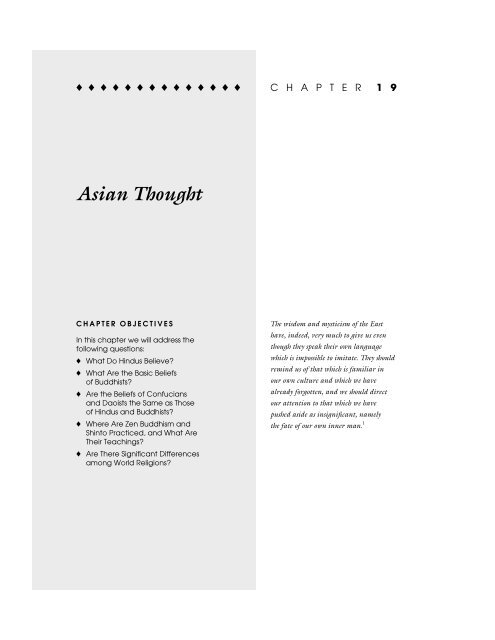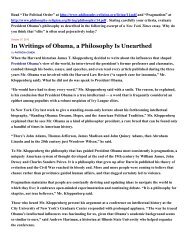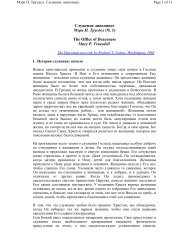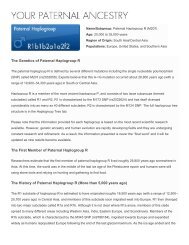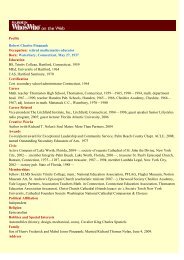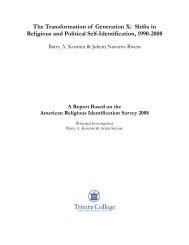Asian Thought - Philosophy and Religion
Asian Thought - Philosophy and Religion
Asian Thought - Philosophy and Religion
- No tags were found...
You also want an ePaper? Increase the reach of your titles
YUMPU automatically turns print PDFs into web optimized ePapers that Google loves.
◆ ◆ ◆ ◆ ◆ ◆ ◆ ◆ ◆ ◆ ◆ ◆ ◆ ◆ C H A P T E R 1 9<strong>Asian</strong> <strong>Thought</strong>CHAPTER OBJECTIVESIn this chapter we will address thefollowing questions:◆ What Do Hindus Believe?◆ What Are the Basic Beliefsof Buddhists?◆ Are the Beliefs of Confucians<strong>and</strong> Daoists the Same as Thoseof Hindus <strong>and</strong> Buddhists?◆ Where Are Zen Buddhism <strong>and</strong>Shinto Practiced, <strong>and</strong> What AreTheir Teachings?◆ Are There Significant Differencesamong World <strong>Religion</strong>s?The wisdom <strong>and</strong> mysticism of the Easthave, indeed, very much to give us eventhough they speak their own languagewhich is impossible to imitate. They shouldremind us of that which is familiar inour own culture <strong>and</strong> which we havealready forgotten, <strong>and</strong> we should directour attention to that which we havepushed aside as insignificant, namelythe fate of our own inner man. 1
The Nature of<strong>Asian</strong> <strong>Religion</strong>◆ ◆ ◆ ◆ ◆ ◆ ◆ ◆ ◆ ◆ ◆We live in an increasinglyinternationalworld, where relationsbetween <strong>Asian</strong> countries<strong>and</strong> those of Europe <strong>and</strong> the Americas havebecome more crucial than ever before. Modernscience <strong>and</strong> technology have created for the firsttime in recorded history a universal pattern ofcivilization, a world society which desperatelyneeds some underst<strong>and</strong>ing of diversity.There is great diversity among world religions.For hundreds of millions of <strong>Asian</strong>s, theirreligion—no matter what form it takes—is a vitalconcern of their daily lives, not a mere oneday-a-weekobservance. The peoples of non-Western cultures see religion as integrally relatedto <strong>and</strong> inseparable from all the other areas of life<strong>and</strong> experience. They generally look upon theirreligion as the basis of their culture, which givesform <strong>and</strong> meaning to the rest of existence. Ourattempt here is to underst<strong>and</strong> certain beliefsabout the transcendent, humanity, <strong>and</strong> the universethat have been the basis of well-establishedcultures <strong>and</strong> beautiful art in the <strong>Asian</strong> world.<strong>Asian</strong> philosophy is a way of life.The HinduTradition“Hinduism, literally‘the belief of the peopleof India,’ is the predominantfaith of India◆ ◆ ◆ ◆ ◆ ◆ ◆ ◆ ◆ ◆ ◆<strong>and</strong> of no other nation.” 2 Taken as a whole, Hinduismis one of the oldest religious traditions inthe world. But it is difficult to study, for it is alsoone of the most diversified religious traditions.There are divisions <strong>and</strong> subdivisions into whichwe cannot go, <strong>and</strong> you should be aware that weare necessarily oversimplifying in this discussion.The problem is further complicated by the factthat there are no exact equivalents in English forcertain Indian terms <strong>and</strong> concepts.<strong>Philosophy</strong> (darshana) in the Hindu traditionmeans “seeing the truth” <strong>and</strong> applying thistruth to the problems of everyday life. Thus, forIndian thinkers, the purpose of studying philosophyis not merely to gain knowledge for its ownsake or to satisfy one’s curiosity, but to discover<strong>and</strong> live the highest kind of life, the life that willbring permanent self-realization or bliss. Peoplemust recover truths themselves, not just acceptthem on blind faith or from the testimony of others.Unless people have convictions <strong>and</strong> live in accordancewith them, they are not philosophers.Hinduism arose on Indian soil <strong>and</strong> is largelyconfined to Indian people. India, however, hasknown other traditions, including Buddhism,Christianity, <strong>and</strong> Islam. What is called Hinduismtoday has influenced many other parts of Asia<strong>and</strong> is steadily growing in parts of Europe <strong>and</strong>the United States.HINDU SCRIPTUREOne indication of the difficulty of setting forththe central points in Hindu thought is that thereare many texts that, collectively, can be calledHindu Scripture. First, there are the Vedas (literally“knowledge”—that is, sacred knowledge).These are texts written some fifteen hundredyears before the common era. The earliest textsare the Rig Veda, a collection of over one thous<strong>and</strong>hymns addressed to the gods—hymns toIndra, the god of civilization, war, <strong>and</strong> storm; toVaruna, the guardian of morality; <strong>and</strong> to manyothers, most of them now forgotten. Included inthe Vedas are the Brahmanas, lengthy treatisesconcerned with the details of the sacrificial ritualadministered by the Brahmin class. Finally, in theeighth to fifth centuries B.C.E., there were addedto these the most famous of the early Indianwritings, the Upanishads, which attempted toexplain the inner meaning of the reality behindthe religious quest in a philosophical manner. Allthese writings form the essential canon of sacredscriptures in the orthodox Hindu tradition.In the period following the Upanishads,there was, within Hinduism, a great developmentof devotional religion. This was expressedstrikingly in the most famous of Indian scriptures,the Bhagavadgita, or “Song of the Lord.”There is some doubt as to when the Gita wascompiled, but it was probably some time duringthe period 200 B.C.E to 200 C.E. No other scrip-408 ◆ Chapter 19
ture is more widely read in India today. To readthe Gita is to be introduced to some of the mainthemes of Hindu thought as well as to some ofthe main practices of Hindu life. It also introducesone to splendid Hindu poetry <strong>and</strong> to thegod Krishna.It is convenient to name four major periodsof Hindu thought: first, the early period of Vedicpolytheism; second, the period of the Vedanta(literally, “the end of the Veda”), with its descriptionsof Absolute Brahman; third, a periodbeginning about 200 B.C.E., with an emphasis onbhakti (devotional worship of a theistic god);<strong>and</strong> last, the modern period, with its responseto Western influence. 3“During the classicalperiod—those centuries between 450 B.C. <strong>and</strong>A.D. 600—occurred the emergence of a Hinduculture that absorbed into itself many differentstr<strong>and</strong>s of mythology, ritual, <strong>and</strong> doctrine. Thisluxuriance of religious st<strong>and</strong>points may sometimesbaffle the outsider, but it testifies to an important<strong>and</strong> enduring characteristic of Indianculture—its desire to express <strong>and</strong> to nurture asmany different approaches to the Truth as possible,<strong>and</strong> to conserve within itself the multiplicityof cultural influences that have affected theIndian subcontinent.” 4BRAHMAN AND THE SELFCentral to much of Hindu philosophy is the emphasison the one unchanging reality that transcendsspace, time, causality, <strong>and</strong> all particularthings. This Absolute cannot be comprehendedby human thought or adequately expressed inwords <strong>and</strong> concepts. According to the nondualisticview (which emphasizes the oneness of existence)only Brahman is real, <strong>and</strong> the individualsouls <strong>and</strong> the universe are illusory veils obscuringBrahman. Other views hold that the self <strong>and</strong> thephysical world may be real, although they are finite<strong>and</strong> imperfect. There are also differencesamong philosophical thinkers about whether theultimate reality is nonpersonal, superpersonal, orpersonal. But all agree on the possibility of everysoul’s attaining liberation (moksha) from thebondage of the physical world.Closely allied to the concept of Brahman isthe concept of the self, or soul, or atman. Thetrue self of each person is identical with Brahman.From the transcendental st<strong>and</strong>point, theself is immortal, free, <strong>and</strong> identical with Brahman.The divine nature of the self is veiled, butnot destroyed, by false images <strong>and</strong> ignorance, forit is ultimately without traits <strong>and</strong> beyond language.The true destiny of the self is the realizationof this identity with Brahman. From thephenomenal st<strong>and</strong>point, there are many individualselves, enmeshed in the world of affairs <strong>and</strong>seeking deliverance from the round of births <strong>and</strong>deaths. Thus we need to distinguish between thereal <strong>and</strong> the empirical self.What are the relations among Brahman, theself, <strong>and</strong> the universe that we perceive? A Hinduscholar says: “Brahman is the sole reality, <strong>and</strong> itappears both as the objective universe <strong>and</strong> as theindividual subject. The former is an illusorymanifestation of Brahman, while the latter isBrahman itself appearing under the limitationswhich form part of that illusory universe.” 5 Theobjects of the empirical world, although of a certainorder of worldly reality, are appearances inthat they belong to the world of cause <strong>and</strong> effect,to which Brahman does not belong. The individualself, however, is not illusory in this sense.The self is Brahman appearing under limitingconditions. It is not a phenomenon of ignorancethe way physical objects are. Through an intuitive,non-logical experience one realizes theidentity of the eternal self <strong>and</strong> Brahman.CENTRAL VALUES IN HINDUISMAll Hindu systems of thought seem to agreethat there are four main values to be completed<strong>and</strong> brought to perfection in the course of rebirth.In ascending order of importance they are:(1) Artha (wealth) <strong>and</strong> (2) Kama (sensuality).These are the worldly or secular values. They arelegitimate if they are kept in their places <strong>and</strong> donot stifle other values. Material prosperity, goodhealth, <strong>and</strong> long life are desired by most Indians.However, both the life of activity <strong>and</strong> renunciationare recognized. (3) Dharma (social <strong>and</strong><strong>Asian</strong> <strong>Thought</strong> ◆ 409
individual duties) includes all caste roles <strong>and</strong>obligations of occupation, gender, kin, generation,<strong>and</strong> temperament, as well as other ethicalresponsibilities. (4) Moksha (release from finitude<strong>and</strong> imperfection) is the intrinsic or eternalvalue, <strong>and</strong> the supreme spiritual ideal. It givesliberation from the wheel of existence, <strong>and</strong> cannotbe achieved without complete experience<strong>and</strong> resolution of the other three. Discipline isessential if we are to achieve illumination, <strong>and</strong>the overcoming of selfishness is essential if we areto realize our genuine self <strong>and</strong> attain release. Unlessa person achieves release in this life, which israre indeed, she or he is destined to repeat theround of more existences.According to Hinduism, no soul is eternallydamned. The law of karma, the law of sowing<strong>and</strong> reaping, determines the form that will betaken in each new existence. This is the law ofcause <strong>and</strong> effect in human life. Through our conductwe determine our own destiny in that goodkarma is acquired by living up to our dharmicduties <strong>and</strong> bad karma by ignoring or violatingour given dharma. An unethical life may lead torebirth below the station of the present life, <strong>and</strong>a life of goodness may lead to a more favored existenceor to ultimate liberation from the roundof rebirths. Thus, the doctrines of karma <strong>and</strong> rebirthare said to be grounded in the moral structuresof the universe. They permit freedom <strong>and</strong>ethical advance in that they are under our control<strong>and</strong> are not determined by cosmic or environmentalforces completely beyond our influence.Because of its intricate dependence on thestructure of dharma, the theory of karma <strong>and</strong>rebirth determines a person’s position in the traditionalcaste system, in which there are fourmain castes <strong>and</strong> many subcastes or divisionswithin these. The caste system has been underattack in recent decades, having been outlawedin the Indian Constitution of 1949, <strong>and</strong> variousoutst<strong>and</strong>ing leaders of Hinduism have called attentionto the continued abuses of caste <strong>and</strong>have worked hard to bring about its practicalelimination. Nevertheless, the caste system ishighly resistant to change, not only because ofthe belief that a person’s present social status isregulated by the law of karma but also becauseof ingrained social hierarchies based on notionsof purity <strong>and</strong> contamination.The concept of the four ashramas, or stagesin the life of the individual, relates the goal of liberationto the needs <strong>and</strong> tasks of daily life in society.A man’s duties are set by the stage of life atwhich he has arrived. The four stages are (1) thelife of a celibate student under the mentorship ofa teacher; (2) a long period of householdership,beginning with marriage, when a person assumesthe responsibilities of parenthood <strong>and</strong> other socialobligations <strong>and</strong> when one provides for thosededicated to the spiritual quest; (3) a period ofincreased religiosity, when householder dutiescan be passed on to the next generation, duringwhich one retires to the forest with his wife topractice rituals <strong>and</strong> for meditation <strong>and</strong> reflection;<strong>and</strong> (4) by complete renunciation of family<strong>and</strong> caste <strong>and</strong> by practicing austerities <strong>and</strong> rigidself-control, a person seeks union with Brahman.If the person is successful in the fourth stage,struggle <strong>and</strong> strife cease <strong>and</strong> he gains peace <strong>and</strong>freedom through union with the all-embracingWorld Soul. The inner spirit of humanity is thefocus of attention, <strong>and</strong> its development, illumination,<strong>and</strong> release are the highest values. Thesestations were primarily for men. At the time oftraditional Hinduism, women were excludedfrom the more rigorous structures of the ashramas<strong>and</strong> received their spiritual merit from workingto uphold the dharmic obligations of theirhusb<strong>and</strong>s.YOGAWe have already mentioned that, for the Hindu,discipline is essential if one is to achieve illumination:discipline of both body <strong>and</strong> mind.Yoga is a technique of physical <strong>and</strong> spiritualtraining by which the bodily <strong>and</strong> psychic energiesare controlled, unified, <strong>and</strong> directed in orderto attain liberation from the world. Yoga is theliberating union of the self (atman) with the Self(Brahman).410 ◆ Chapter 19
In classical yoga, after the yogi has undergonea long initiatory period of training under amaster—the guru—no one else need exist in hisor her world. The yogi sheds not only materialdistractions but also psychic hindrances such asmemories, desires, fears, yearnings, <strong>and</strong> theresidue of dreams <strong>and</strong> impressions; all with thegoal of liberation. The importance of classicalyoga is that it teaches the complete independence<strong>and</strong> freedom of the self based on the confidencethat the individual mind is able throughits own powers to transcend the suffering causedby matter, illusions, <strong>and</strong> supernatural agencies.Only knowledge can bring liberation. Withoutthis goal, everything—study, work, meditation—isvalueless.RELIGIOUS EXPRESSIONSTraditional worship of a god in Hinduism isknown as puja. It can be practiced by anyone regardlessof gender, age, or station in life, fromthe most erudite philosopher to the simpliststreet sweeper. Because Hinduism is not normallya congregational religion that is practicedin a house of worship by people as a group, theperformance of puja is left to the individual.Usually there is a puja room or niche within theHindu home, where an image of the god or goddessis enshrined in a painting, a sculpture, orother symbolic referent with flowers, incense,<strong>and</strong> food. The divinity is invoked with symbolicsounds, prayers, <strong>and</strong> songs, <strong>and</strong> often worshipincludes the use of fire or water. The choice ofgod or gods, whether it be Krishna, Rama, Shiva,Kali, Shri, or any one of a great variety from theHindu pantheon, is often a matter of family affiliationor the needs of a given worship. Hindutemples, cared for <strong>and</strong> presided over by priests,are usually dedicated to a specific divinity <strong>and</strong>provide an especially quiet place for individualdevotion. Seasonal festivities commemoratinglocal myths <strong>and</strong> figures are expressive <strong>and</strong> celebratoryaffairs, often lasting many days <strong>and</strong> includingpeople from all social backgrounds. Finally,Hindu worship can take the form ofpilgrimage to area shrines or to the holy city ofKashi (modern Banaras) <strong>and</strong> its sacred riverGanges. Possessing great adaptability <strong>and</strong> tolerance,Hinduism includes, rather than excludes,unique forms of religious expression. There are anumber of reform movements in India today,<strong>and</strong> some outst<strong>and</strong>ing thinkers have been remoldingthe Indian consciousness <strong>and</strong> outlook. 6In “The Spirit of Indian <strong>Philosophy</strong>,” SirSarvepalli Radhakrishnan, 7 after pointing out thediversity of views held by Indian thinkers, indicatesseven attitudes that are characteristic of theIndian philosophical mind. (1) Concentrationon the spiritual. <strong>Philosophy</strong> <strong>and</strong> religion areclosely related. Humans are spiritual in nature<strong>and</strong> are primarily interested in their spiritual destiny<strong>and</strong> not in material welfare. (2) Belief in theintimate relationship of philosophy <strong>and</strong> life.(3) The introspective attitude <strong>and</strong> concern forthe inner life. The inner spirit of a person, thesubject rather than the object, is the focus of attention<strong>and</strong> gives the best clue to the nature ofthe universe. (4) The affinity with idealism. Becausereality is “ultimately one <strong>and</strong> ultimatelyspiritual,” the tendency is toward nondualisticidealism. (5) The acceptance of direct perceptionas the only method through which reality can beknown. When the mind becomes free from theimpurities of attachment <strong>and</strong> aversion throughthe practice of yoga or spiritual disciplines, it perceivestruth directly, as one perceives a fruit lyingon the palm of one’s h<strong>and</strong>. Reason is useful butinsufficient; it leads the seeker as far as it can <strong>and</strong>then bows out. To know reality is to experienceit or to become one with it. (6) A consciousnessof tradition <strong>and</strong> an acceptance of the insights ofseers who have lived in the past. This has not,however, made Indian philosophy dogmatic orcreedal. (7) An “overall synthetic tradition.” Thesystems of thought are seen as complementingeach other. This stress on the synthetic visionhad made possible an intellectual <strong>and</strong> religioustolerance toward differences within Hinduism<strong>and</strong> toward other faiths <strong>and</strong> systems of thought.Hinduism is thus not a fixed <strong>and</strong> uniform doctrinalsystem; it is broad, inclusive, <strong>and</strong> tolerantof different points of view.<strong>Asian</strong> <strong>Thought</strong> ◆ 411
The BuddhistQuest forEnlightenmentTHE BUDDHABuddhist philosophyhas much in common◆ ◆ ◆ ◆ ◆ ◆ ◆ ◆ ◆ ◆ ◆ with Hindu philosophy,but it also departsradically from it at certain points <strong>and</strong> hencewas known among adherents of Hinduism asthe “Great Heresy.” Siddhartha Gautama, thefounder of Buddhism (see biography <strong>and</strong> excerpt,pp. 414–415), lived in Northern Indiain the fifth century B.C.E. Gautama, althoughreared in luxury <strong>and</strong> under sheltered conditions,became greatly concerned about the widespreadmisery under which people lived. He left hishome <strong>and</strong> family <strong>and</strong> w<strong>and</strong>ered into the forest insearch of the truth about the meaning of existence.Finally, after six years, <strong>and</strong> lengthy experimentationwith asceticism, he returned to theMiddle Way (see excerpt, pp. 415). One nightshortly thereafter, under the Bo Tree, the truth,it is said, flashed into his mind <strong>and</strong> he became the“Enlightened One”—the Buddha. Contrary tothe spirit of his teaching, Gautama was later idolized<strong>and</strong> deified, <strong>and</strong> temples, ceremonies, <strong>and</strong> apriesthood arose. As a result of Buddha’s teaching<strong>and</strong> influence, Buddhist thought flourishedin India for more than a thous<strong>and</strong> years. Todayit is found mainly in Sri Lanka (Ceylon), Myanmar(Burma), Thail<strong>and</strong>, Tibet, China, Korea,<strong>and</strong> Japan. In the course of its expansion it haschanged considerably.Buddhism makes a fundamental break withHinduism in its rejection not only of the Vedicscriptures but also of the concepts of Brahman<strong>and</strong> atman—the metaphysical absolute <strong>and</strong> thechangeless self. Experience, it is said, gives noclear indication of such an all-inclusive WorldSoul. Gautama rejected the authority ascribedto the ancient gods <strong>and</strong> urged believers to relymainly on the resources within themselves. Healso rejected the caste system; wisdom <strong>and</strong> notbirth or caste is of importance. He was impressedby ceaseless change, which he observedas pervading everything, <strong>and</strong> by finiteness <strong>and</strong>suffering. Gautama was not only a man of greathuman sympathy <strong>and</strong> goodwill; he was a thinkerof great philosophic power who decided tospend his life in teaching others to gain underst<strong>and</strong>ing.THE THREE MARKS OF EXISTENCEAND THE FOUR NOBLE TRUTHSThe central core of Buddhist philosophy is foundin the Three Marks of Existence. By carefully observingour everyday experience, unimpeded bynormal belief systems <strong>and</strong> opinions, we noticethat the world of our senses is marked by transitorinessor impermanence. We then notice anatta,an inability to determine through experientialchannels of knowledge whether or not thereis a Self; this “no doctrine of a Self” quickly becamein early Buddhism the “doctrine of noSelf,” whereby we can find no independentessence in existing things. Finally, we discoverdukkha, suffering, that is experienced because ofour attachment to things which change.The doctrine of the Four Noble Truths thenfocuses on the relationship between suffering<strong>and</strong> attachment or desire. There is, first, the factof the existence of suffering. Unhappiness orpain accompanies the experiences of birth, illness,failure to satisfy desires, separation fromfriends <strong>and</strong> loved ones, old age, <strong>and</strong> death. Theproblem of suffering is the universal problem oflife in a world that is finite <strong>and</strong> changing. Eventhe more fortunate are unable to ward off oldage <strong>and</strong> death.The second noble truth discloses the causeof suffering. Suffering is caused by desires, ortanha, which in its original <strong>and</strong> literal meaning is“thirst.” These desires or cravings are many, <strong>and</strong>they tend to grow or increase as we attempt tosatisfy them. The greatest attachment, however,is to existence itself, for what we want most isto continue indefinitely, to have life as we nowknow it. The world, however, is marked bychange <strong>and</strong> it is our attachment to these changingthings (<strong>and</strong> especially to our own selves) thatcauses us the greatest suffering.The third noble truth is that release is possible.Because we cannot alter the transitory natureof the experiential world, we have to focus412 ◆ Chapter 19
our attention on something else: our attachmentto this world. By getting rid of our attachment<strong>and</strong> desire we automatically get rid of our suffering.By eradicating our desire, we also reduceour ignorance <strong>and</strong> see for the first time the truenature of the self as a conditioned entity interdependentwith all other things in a “chain ofcausation.” Real happiness comes with this freedomfrom attachment <strong>and</strong> if we can gain suchenlightenment, the wheel of existence can beended <strong>and</strong> nirvana experienced.The fourth noble truth is that there is a wayout through the Noble Eightfold Path. Rightknowledge about the nature of one’s self is ameans of removing attachment <strong>and</strong> suffering.THE NOBLE EIGHTFOLD PATHAND NIRVANAThe Noble Eightfold Path consists of the followingsteps: (1) Right underst<strong>and</strong>ing. We needto realize that the cessation of suffering comesthrough the elimination of ignorance <strong>and</strong> ofcraving, desire, <strong>and</strong> thirst for a world <strong>and</strong> a selfmarked by transitoriness. Without underst<strong>and</strong>ing,we do not know the direction from whichrelease is to come. (2) Right aspiration or purpose.Without the goal of enlightenment we arenot likely to make a start or to put forth vigorouseffort. (3) Right speech. We should betruthful, kind, <strong>and</strong> humble, <strong>and</strong> never gossip,sl<strong>and</strong>er, or boast. (4) Right conduct. We mustnot harm other living creatures <strong>and</strong> must avoidkilling, stealing, eating meat, intoxication, <strong>and</strong>other evils. (5) Right mode of livelihood. Ourmode of living <strong>and</strong> our vocation should be inharmony with the goals toward which we aspire<strong>and</strong> should be especially consistent with theethics of nonviolence. (6) Right striving oreffort. Discipline is necessary in the attainmentof knowledge. (7) Right mindfulness. Ourthoughts are important, <strong>and</strong> must not be permittedto w<strong>and</strong>er or dwell on desires that needto be suppressed. (8) Right concentration.When we are able through meditation <strong>and</strong> concentrationto identify ourselves with truth, thegoal of mystic illumination is reached. At thispoint we are no longer subject to rebirth, <strong>and</strong> wemay achieve the experience of nirvana.What is nirvana? Literally, the term means“blowing out, extinction, ceasing to be.” Doesthis mean that Buddhist thinkers have set forth areligion or philosophy of escape? Such, however,would be a superficial interpretation, which inno way explains the sense of joyous fulfillment<strong>and</strong> the appeal of Buddhism to large numbers ofpeople. What is extinguished is attachment toany belief in an eternal, permanent self <strong>and</strong> to allnotions of individuality. The elimination of thebonds of rebirth, of suffering, of ignorance, ofdesire, is the liberation that is nirvana. Cessationof striving, being bound by rebirth, is said tobring a sense of liberation or freedom, peace <strong>and</strong>contentment, joy, insight, <strong>and</strong> love or compassionfor all living beings.In order to achieve this freedom, compassion,<strong>and</strong> wisdom, certain ethical behaviors mustbe followed. In the earliest Buddhist dialoguesfive prohibitions are given:1. Avoid taking life (animal or human).2. Avoid stealing (taking what is not offered).3. Avoid illicit sexual relations.4. Avoid lying.5. Avoid intoxicants. 8The law of karma <strong>and</strong> the doctrine of rebirthwere retained by Buddhists when they rejectedHinduism. The law of karma is a strongincentive to choose the good <strong>and</strong> avoid its opposite.If we realize that we are our own saviors,our sense of responsibility is likely to be keen.One should give aid to others, however, wheneverthis is possible, physically through almsgiving<strong>and</strong> the like, <strong>and</strong> spiritually throughknowledge <strong>and</strong> enlightenment.DIVISIONS WITHIN BUDDHISMAlthough Buddhism arose in India <strong>and</strong> flourishedthere for more than one thous<strong>and</strong> years, itis found today mainly in other countries of Asia. 9In the course of its development, Buddhismmoved from early Buddhism <strong>and</strong> split into two<strong>Asian</strong> <strong>Thought</strong> ◆ 413
◆ ◆ ◆ ◆ ◆ ◆ ◆ ◆ ◆ ◆ ◆ ◆ ◆ ◆ ◆The BuddhaSiddhartha Gautama (fifth century B.C.E.) was the founderof the Buddhist religion. His father was a chieftain or king inNorthern India. Siddhartha was “the man who had everything”:he was h<strong>and</strong>some <strong>and</strong> wealthy <strong>and</strong> had a model wife <strong>and</strong> a babyson. It is said that at the time of his birth a prophetic sage predictedthat if he became attached to the world <strong>and</strong> its ways, hewould unify India <strong>and</strong> become a great conqueror; if he saw thetrue nature of the human condition <strong>and</strong> forsook the world, hewould become a world redeemer.His father wanted to keep him attached to the world, butSiddhartha eventually turned from material things. On one occasionwhen he was horseback riding, he saw in turn a decrepit oldman, a man racked with pain <strong>and</strong> disease, <strong>and</strong> a corpse. Thus hediscovered the facts regarding old age, disease, <strong>and</strong> death; he becametroubled over the sorrows of human life <strong>and</strong> felt a deep desireto help. He also saw a w<strong>and</strong>ering holy man with simple garb<strong>and</strong> a shaved head. At age 29, he left the palace <strong>and</strong> his family,<strong>and</strong> went off alone to seek release from the misery of the world,to discover the cause of human suffering, <strong>and</strong> to find its spiritualcure. This was the “Great Renunciation.”After some years of searching, during which he tried asceticism,extreme self-mortification, <strong>and</strong> more moderate programsof meditation, insight <strong>and</strong> enlightenment came while he wassitting under a sacred Bo tree. He became the Buddha, theEnlightened One. Buddha then spent his long life teaching<strong>and</strong> preaching. He established an order of monks <strong>and</strong> lateran order of nuns. His teachings are founded in the “ThreeMarks of Existence,” the “Four Noble Truths,” <strong>and</strong> the“Noble Eightfold Path.”414 ◆ Chapter 19
Excerpt from:The Buddha’s First Sermon,known as The Foundation of theKingdom of Righteousness or TheSetting in Motion of the Wheelof the Dhamma, taken from theMahavaggaNote: To read Buddhist literature, you should underst<strong>and</strong> that theseare not historical documents in the sense of precise, objective recordingsof events. Happenings in the life of the Buddha, reports of dialoguesbetween various individuals, parables <strong>and</strong> stories—all thesewere set down long after the time of the Buddha <strong>and</strong> were shaped toteach his ideas as later generations came to underst<strong>and</strong> them.This, monks, is the Middle Path, the knowledge of whichthe Tathagata has gained, which leads to insight, which leads towisdom, which conduces to calm, to knowledge, to perfect enlightenment,to Nirvana.This, monks, is the Noble Truth of Suffering: birth is suffering;decay is suffering; illness is suffering; death is suffering;presence of objects we hate is suffering; separation from objectswe love is suffering; not to obtain what we desire is suffering.In brief, the five aggregates which spring from grasping,they are painful.This, monks, is the Noble Truth concerning the Origin ofSuffering: verily it originates in that craving which causes therenewal of becomings, is accompanied by sensual delight, <strong>and</strong>seeks satisfaction now here, now there; that is to say, craving forpleasures, craving for becoming, craving for not becoming.This, monks, is the Noble Truth concerning the Cessationof Suffering: verily, it is passionless, cessation without remainderof this very craving; the laying aside of, the giving up, the beingfree from, the harboring no longer of, this craving.This monks, is the Noble Truth concerning the Path whichleads to the cessation of Suffering: verily, it is this noble EightfoldPath, that is to say, right views, right intent, right speech,right conduct, right means of livelihood, right endeavor, rightmindfulness, <strong>and</strong> right meditation.This is the Noble Truth concerning suffering. Thus,monks, in things which formerly had not been heard of have Iobtained insight, knowledge, underst<strong>and</strong>ing, wisdom, intuition.This Noble Truth concerning Suffering must be understood.Thus, monks, in things which formerly had not been heard ofhave I obtained insight, knowledge, underst<strong>and</strong>ing, wisdom,<strong>and</strong> intuition.Clarence H. Hamilton, ed., Buddhism: A <strong>Religion</strong> of InfiniteCompassion (New York: Liberal Arts Press, 1952), p. 29.<strong>Asian</strong> <strong>Thought</strong> ◆ 415
main branches with various subdivisions withineach of these branches. The first branch, Theravada(“Doctrine of the Elders”), or Hinayana(“Small Vehicle”), or Pali Buddhism, prevailsmainly in Sri Lanka (Ceylon), Myanmar(Burma), <strong>and</strong> Thail<strong>and</strong>. It was a more conservative<strong>and</strong> individualistic philosophy of escapefrom suffering. Buddha is represented as a greatteacher <strong>and</strong> master who taught the true way; heis not seen as an incarnation of a cosmic principleor power. Theravada Buddhism, a movementin which monks were central, is now becoming alaypersons’ movement <strong>and</strong> showing considerablevitality. The second branch, Mahayana(“Great Vehicle”) Buddhism, is found mainlyin China, Mongolia, Nepal, Tibet, Korea, <strong>and</strong>Japan. It is a more broad-minded philosophywith a universal outlook, <strong>and</strong> it stresses thevirtues of wisdom <strong>and</strong> love. Without minimizingindividual enlightenment <strong>and</strong> freedom from illusion,there is greater stress on compassion for allliving beings. For example, a Bodhisattva is onewho, like Buddha, having attained enlightenment,refuses to enter the fully enlightened stateso as to be able to continue to serve his or herfellows. Whereas Theravada Buddhism conceivesthe Buddha as a human <strong>and</strong> stresses individualenlightenment, in the Mahayana branch ofBuddhism the Buddha is more likely to be conceivedas the transcendental eternal principle orAbsolute, which may bring release to all people.Confucius<strong>and</strong> Lao-zi*Chinese civilizationwas old when Westerncivilization was in the◆ ◆ ◆ ◆ ◆ ◆ ◆ ◆ ◆ ◆ ◆process of formation.About the sixth century B.C.E., Confucius <strong>and</strong>Lao-zi attempted to organize the wisdom of thetime into a more orderly system. Both men livedin a period of unrest <strong>and</strong> confusion, <strong>and</strong> theysought to restore peace <strong>and</strong> harmony amongpeople <strong>and</strong> between them <strong>and</strong> the order of na-*The Pinyin System of romanization (spelling) of Chinesecharacters is used in the text of this chapter.ture. Lao-zi taught that behind all existence isthe impersonal Dao (Way). Dao is the way theuniverse works; it is the reality that is immanentin nature <strong>and</strong> humanity. Confucius revised <strong>and</strong>systematized the earlier classics. He was an ableteacher <strong>and</strong> administrator, with a practical turn ofmind, more interested in helping his people livewell than in considering speculative questions.The teachings of Confucius were reaffirmedby Mencius (Meng-zi), a Chinese philosopherwho lived one century later. For twenty-five centuries,Chinese ethical ideals, in the form knownas “Confucianism,” were influential in the developmentof Chinese culture. With the establishmentof the People’s Republic in 1949 byMao Ze-dong, the habits <strong>and</strong> customs of Chinesesociety were radically transformed. Many ofthese customs are returning.<strong>Philosophy</strong> among the Chinese has tended,on the whole, to be practical <strong>and</strong> this-worldly.The interest is in achieving a harmonious adjustmentto other people, to society in general, <strong>and</strong>to the dem<strong>and</strong>s of nature. There is less emphasison questions of logic, epistemology, <strong>and</strong> metaphysicsthan on moral problems <strong>and</strong> social philosophy.Chinese writers, furthermore, tend toset forth their convictions in the form of aphorisms,illustrations, <strong>and</strong> stories that convey generalmeaning but omit analytical precision, systematicreasoning, <strong>and</strong> argument. For example,in the Confucian Analects the paragraphs consistof only a few words or perhaps a few sentences.THE ORDER IN NATURETraditional Chinese philosophy is predominantlya system of ethical realism. Operating throughhuman life <strong>and</strong> the universe is “one all-pervadingprinciple, rational <strong>and</strong> ethical in nature.” 10 Forthe Chinese, says Francis C. M. Wei, “orderliness<strong>and</strong> regularity are the fundamental characteristicsof the universe.” 11 The concepts of Heaven(Tian) <strong>and</strong> the Dao, or Way, are prominent.Heaven, for the Confucians, is the dependableorder of the Universe <strong>and</strong> the ground <strong>and</strong>guardian of the moral law. Heaven not only governshuman affairs in accordance with the moral416 ◆ Chapter 19
order of things but gives us a disposition towardharmony <strong>and</strong> the right. Dao, for the Daoists, aswe have seen, is the way the universe works <strong>and</strong>the reality that is immanent in nature <strong>and</strong> humanity.The Dao of Heaven transcends the ordinaryexperience of nature <strong>and</strong> humanity, givesmeaning to the universe, <strong>and</strong> helps us do thingsin the right way. When Heaven is described inpersonal terms, it may be thought of as Transcendenceor Providence. When Heaven is describedin impersonal terms, it may be regardedas the “law of nature” or as fate, which determinesnatural <strong>and</strong> human events.In Chinese philosophy, the stress is on thedynamic <strong>and</strong> changing nature of the process inthe midst of which we live. This resembles someWestern “process” philosophies. From earlyChinese thinking, the concepts “Yang” <strong>and</strong>“Yin” have been inherited. Yang is the activeforce that is the initiating, creative factor in existence;Yin is the more passive <strong>and</strong> receptive factor.Through the interaction of these two forces,natural processes go on.HUMANITY AND THE GOOD SOCIETYIn Confucianism, humans occupy a high place inthe general scheme of things; we alone can underst<strong>and</strong>the order of things <strong>and</strong> live accordingto a moral ideal. Normal persons ought to aspireto be superior people. They should strive fortheir own development, renounce worldly lusts,<strong>and</strong> become courteous <strong>and</strong> gentle. Such personsexhibit integrity of mind in that they are honestwith themselves <strong>and</strong> with others. They are sincerein speech <strong>and</strong> action <strong>and</strong> moderate in allthings. They avoid avarice, quarrelsomeness, <strong>and</strong>covetousness, <strong>and</strong> delight in aiding others. Suchsuperior persons do not go to excess in any direction.They exercise moderation <strong>and</strong> strive forthe “golden mean” or the “just medium,” whichenables virtue <strong>and</strong> happiness to continue <strong>and</strong>increase through history.Until the Maoist revolution, the concepts ofthe community <strong>and</strong> of social propriety were centralin Chinese culture. The basic institution wasthe family, which usually contained as a householdnot only the parents <strong>and</strong> unmarried childrenbut all the sons with their wives <strong>and</strong> children<strong>and</strong> other dependent relatives. Reverencefor ancestors <strong>and</strong> elders was extremely strong intraditional Chinese society. Different attitudeswere called for depending on whether a personwas dealing with parents, spouse, an official orl<strong>and</strong>owner, a child, or whomever. Different personshad different duties <strong>and</strong> “places” accordingto their abilities <strong>and</strong> their stations in life.Before the introduction of Buddhism inChina, Chinese religious <strong>and</strong> ethical ideals weredominated by Confucianism <strong>and</strong>, to a lesserextent, by Daoism. Confucianism was concernedmainly with personal <strong>and</strong> social relations,whereas Daoism cultivated a sense of the individual’soneness or unity with the order of theuniverse, while putting less emphasis on conventions<strong>and</strong> rules. When Buddhism was introducedinto China, many educated Chinese adopted itbecause of its comprehensive <strong>and</strong> systematiccharacter. For a number of centuries, many ofthe ablest Chinese thinkers were Buddhists orwere profoundly influenced by Buddhist ideas.Mao Ze-dongMarxism 12has taken◆ ◆ ◆ ◆ ◆ ◆ ◆ ◆ ◆ ◆ ◆ firm root in China today<strong>and</strong> perhaps maybe regarded as a fourth religion in Chinesehistory. Mao Ze-dong (1893–1976), politicalleader, statesman, poet, <strong>and</strong> philosopher, took ashis goal the radical transformation of Chinesesociety. He was guided in this enterprise by ideasof Western origin, first, nineteenth-century liberalism,<strong>and</strong>, then Leninist collectivism. But atthe same time he was determined that this“people’s China” should place a high value on itsown culture.A basic aspect of revolutionary change intwentieth-century China has been the effort ofyoung intellectuals to break away from the dependenttraditions of the old society. Dissatisfactionwith the restrictions of traditional familylife led many educated young Chinese at the turnof the century to seek new ways of modernizingtheir society. Mao Ze-dong was one of numerous<strong>Asian</strong> <strong>Thought</strong> ◆ 417
◆ ◆ ◆ ◆ ◆ ◆ ◆ ◆ ◆ ◆ ◆ ◆ ◆ ◆ ◆ConfuciusKong fu-zi (6th–5th cent. B.C.E.), whom the modern Westernworld calls Confucius, was a teacher <strong>and</strong> administrator whosedown-to-earth philosophy has shaped the history of China tothe twentieth century. He has been called the most influential<strong>and</strong> most revered person in Chinese history. The youngest ofeleven children whose father died at an early age, he grew up inordinary circumstances <strong>and</strong> became a self-educated man by hardwork. He held various governmental positions, including ministerof justice. His main contribution came through his teaching.He made no claim to originality <strong>and</strong> said that he was a transmitterof the wisdom of the ancient sages. He stressed literature,principles of conduct, <strong>and</strong> statecraft. The task of education, hesaid, was to produce the superior person. The ideal is the harmonyof the individual <strong>and</strong> the well-ordered society based onthe mutual respect <strong>and</strong> moral obligation between ruler <strong>and</strong> minister,father <strong>and</strong> son, elder brother <strong>and</strong> younger brother, husb<strong>and</strong><strong>and</strong> wife, <strong>and</strong> friend <strong>and</strong> friend. Among the many virtueshe stressed are filial piety <strong>and</strong> benevolent love. His teachings,found mainly in the Analects (4th cent. B.C.E.), a collection ofhis aphorisms, became part of the Chinese classics.418 ◆ Chapter 19
Excerpt from Confucius:The Analects*Note: The Analects is a collection of sayings by Confucius <strong>and</strong> hispupils pertaining to his teachings <strong>and</strong> deeds. It was probably puttogether by some of his pupils <strong>and</strong> their pupils.1:1. Confucius said, “Is it not a pleasure to learn <strong>and</strong> to repeator practice from time to time what has been learned? Is itnot delightful to have friends coming from afar? Is one nota superior man if he does not feel hurt even though he isnot recognized?”1:2. Yu-Tzu said, “Few of those who are filial sons <strong>and</strong> respectfulbrothers will show disrespect to superiors, <strong>and</strong> therenever has been a man who is not disrespectful to superiors<strong>and</strong> yet creates disorder. A superior man is devoted to thefundamentals (the root). When the root is firmly established,the moral law (Tao) will grow. Filial piety <strong>and</strong>brotherly respect are the root of humanity.1:3. Confucius said, “A man with clever words <strong>and</strong> an ingratiatingappearance is seldom a man of humanity.”1:4. Tseng-Tzu said, “Every day I examine myself on threepoints: whether in counseling others I have not been loyal;whether in intercourse with my friends I have not beenfaithful; <strong>and</strong> whether I have not repeated again <strong>and</strong> again<strong>and</strong> practiced the instructions of my teacher.”1:6. Young men should be filial when at home <strong>and</strong> respectful totheir elders when away from home. They should be earnest<strong>and</strong> faithful. They should love all extensively <strong>and</strong> be intimatewith men of humanity. When they have any energyto spare after the performance of moral duties, they shoulduse it to study literature <strong>and</strong> the arts.1:8. Confucius said, “If the superior man is not grave, he willnot inspire awe, <strong>and</strong> his learning will not be on a firm foundation....When you have made mistakes, don’t be afraidto correct them.The Wade-Giles system of transliteration has been kept in this quoted material,as in others in this chapter.Wing-Tsit Chan, ed. <strong>and</strong> trans., A Source Book in Chinese<strong>Philosophy</strong>, (Princeton: Princeton University Press, 1963).<strong>Asian</strong> <strong>Thought</strong> ◆ 419
◆ ◆ ◆ ◆ ◆ ◆ ◆ ◆ ◆ ◆ ◆ ◆ ◆ ◆ ◆Lao-ziThe age of a hundred philosophers in China (6th–5th cent.B.C.E.) gave rise to myriad new forms of thought, but none hasso beguiled us spiritually as that of Lao-zi. <strong>Thought</strong> to be a contemporaryof Confucius, Lao-zi was an archivist at the courtpalace of Loyang. Legend tells us that when he was about 60,Lao-zi grew weary of a world of chaos <strong>and</strong> social fragmentation<strong>and</strong> set off w<strong>and</strong>ering to the west. The western gatekeeper askedhim to deposit his wisdom before passing, <strong>and</strong> the result was theLao-zi, also titled the Dao De Jing. These aphoristic <strong>and</strong> enigmaticpassages express a view of life that is quietistic, yielding,receptive, <strong>and</strong> ultimately affirming of the world just as it isfound. Humans are but a small part of the larger ebb <strong>and</strong> flow ofnatural change <strong>and</strong> the best chance for survival comes from perfect<strong>and</strong> invisible attunement to one’s surroundings. No oneknows if Lao-zi (which means “old man”) really lived or not,but in the end it may not matter, for as is said in traditionalChina, Daoism is but a state of mind.students alienated from old ways of life, but unlikemany of his contemporaries Mao was sensitiveto the social roots of China’s political order.Early in his life, Mao realized the depth of populardiscontent in China with the existing order ofthings. The problem was how to sustain <strong>and</strong> directsuch mass anger in support of a social revolution.Mao’s rural upbringing made him awareof the tendency of the peasants to avoid politicalinvolvement; they were inclined to eat the bitternessof life’s hardships <strong>and</strong> injustices. But he alsoknew of China’s long tradition of peasant rebellions.His solution to this problem of how to involvea basically conservative rural population ina revolution that would completely reshape peasantlife developed only after years of effort to organizesupport for the communist movement inthe Chinese countryside.On May 4, 1919, the students of Beijingprotested the compromising of Chinese interestsat the Versailles Peace Conference. Theystaged anti-Western political demonstrations<strong>and</strong> sought to reshape their country’s politicaltradition from elitism to mass participation. The“May Fourth” generation, as they becameknown, was deeply influenced by the success ofthe Bolshevik revolution of 1917 in neighboringRussia. Mao Ze-dong found in Marxism–Leninism concepts that could be used to revolutionizeChina, <strong>and</strong> he also saw that China’s revolutionaryintellectuals continued to use theirnew ideology in traditional ways.420 ◆ Chapter 19
Excerpt from Lao-zi:The Dao De JingEmpty your mind of all thoughts.Let your heart be at peace.Watch the turmoil of beings,but contemplate their return.Each separate being in the universereturns to the common source.Returning to the source is serenity.If you don’t realize the source,you stumble in confusion <strong>and</strong> sorrow.When you realize where you come from,you naturally become tolerant,disinterested, amused,kindhearted as a gr<strong>and</strong>mother,dignified as a king.Immersed in the wonder of the Dao,you can deal with whatever life brings you,<strong>and</strong> when death comes, you are ready.As we have seen, the conflicts <strong>and</strong> contradictionsin life did find expression in some ofChina’s philosophical traditions, most explicitlythe Daoist concepts of yin <strong>and</strong> yang. Daoism emphasizedthe ironies <strong>and</strong> tensions inherent insocial institutions; in contrast, however, Confucianism,the philosophy that dominated China’spolitical tradition, sought rule through elite consensusdesigned to produce the harmonious life.Under Mao <strong>and</strong> Communist Party influence, aphilosophy of conflict has influenced Chineseculture. The Marxist–Leninist concepts of dialecticalmaterialism <strong>and</strong> class struggle have held formany Chinese a greater sense of reality thanConfucian harmony, although there is a definiteresurgence of Neo-Confucianism in Taiwan,Hong Kong, <strong>and</strong> to a degree in China itself. MaoZe-dong was only the most influential memberof a generation that rejected the Confucian traditionin favor of a doctrine of struggle <strong>and</strong> change.Inspired by the Marxist dialectic, Mao developeda philosophy of social change. He wrote:Changes in society are due chiefly to the developmentof the internal contradictions in society,that is the contradiction between the productiveforces <strong>and</strong> the relations of production, the contradictionbetween classes <strong>and</strong> the contradictionbetween the old <strong>and</strong> the new; it is the developmentof these contradictions that pushes societyforward <strong>and</strong> gives the impetus for the suppressionof the old by the new. . . . This dialecticalworld outlook teaches us primarily how to<strong>Asian</strong> <strong>Thought</strong> ◆ 421
observe <strong>and</strong> analyze the movement of oppositesin different things <strong>and</strong> ...to indicate methodsfor resolving contradictions. 13The Chinese commitment to the ongoingdialectic has brought many upheavals in the political,social, <strong>and</strong> cultural traditions of China.“Once Mao Tse-tung’s thought is grasped bythe broad masses, it becomes an inexhaustiblesource of strength <strong>and</strong> a spiritual atom bomb ofinfinite power.” 14 Mao himself remarked that hewished to be remembered by future generationsonly as a great teacher. 15 In the Chinese Confuciantradition, however, a teacher has long beenconsidered a model to be emulated by students,a source of authority, rather than just an independentintellect who stimulates students totheir own achievements. Thus Mao, even as ateacher of revolution, is likely to remain a powerfulmodel figure who will long be held up foremulation by China’s millions, a symbol of thetransformation of China. 16The Value Systemof the Japanese◆ ◆ ◆ ◆ ◆ ◆ ◆ ◆ ◆ ◆ ◆Japanese culture hasbeen strongly influencedby Confucianism<strong>and</strong> Chinese culture<strong>and</strong> also by Buddhism <strong>and</strong> Indian culture. Yet inJapan these acquisitions have been remoldedinto something distinctive <strong>and</strong> uniquely Japanese.Because of a common ancestry <strong>and</strong> language<strong>and</strong> because of living on a chain of isl<strong>and</strong>s separatedfrom the mainl<strong>and</strong> of Asia, Japanese peopleshave been able to develop distinctive traits incomparative isolation.SHINTOISMThe Japanese value system goes back to an earlytribal society in which life was centered aroundthe family, the villages, <strong>and</strong> small neighborhoods.Religious values <strong>and</strong> moral st<strong>and</strong>ardswere scarcely distinguished from each other orfrom the problem of keeping order <strong>and</strong> makinga living. The veneration of the sun; worship ofthe kami (the nature spirits); reverence for thespirits of ancestors; <strong>and</strong> respect for <strong>and</strong> loyalty toparents, older people, <strong>and</strong> all those in positionsof authority were part of one’s duties. Shinto isthe name used to cover many of these activities<strong>and</strong> beliefs. At an early date it was the tribal folkreligion centering around the family <strong>and</strong> localshrines (Shrine Shinto), but eventually it becamea patriotic state cult connected with the chieftain<strong>and</strong> court (State Shinto).Shintoism is the traditional Japanese religion.Shinto means literally “the way of thegods,” but the term was not applied until thesixth century C.E., when it was necessary to distinguishthe ancient faith from the encroachingBuddhism. Originally, Shintoism was pantheistic<strong>and</strong> had no written records or written literature,no codified laws, no traditions of philosophicalinquiry, <strong>and</strong> only a rough experience inthe arts <strong>and</strong> sciences. The early belief was that allperceptible objects were in some way alive, inhabitedby good or evil spirits. The first tales tobe composed speak of waterways, vegetation,<strong>and</strong> stones that could talk; however, this wasmore than a simple animism. 17The muchcelebratedJapanese appreciation of nature—a twisted tree, snow falling gently in the distance—cancertainly be traced back to earlyShintoism. Later, however, the original naturedeities were developed into a complex, institutionalreligion, with a priesthood, shrines, <strong>and</strong>monasteries all embodying the cult of the Emperor,as the son of the great Sun Goddess. Fromthis conviction grew the idea of the Emperor asdivine <strong>and</strong> of Shinto as the state religion.ZEN BUDDHISMDuring the early centuries of the common era,Chinese culture, especially Confucianism, <strong>and</strong>Indian cultures by way of Buddhism, had an influencein Japan. The Confucian emphasis onloyalty was carried over into the evolving ethicalcode of the warrior class. Buddhism was introduced<strong>and</strong> changed on Japanese soil. Zen becamethe most influential sect of Buddhism inJapan. As Buddhism moved slowly across Asia, itbegan to receive influences from the different422 ◆ Chapter 19
countries through which it passed. Buddhismreached China as early as the first century C.E.<strong>and</strong> in due course passed on from China to Korea<strong>and</strong> Japan. During these travels <strong>and</strong> transitions,Buddhism developed several divergent forms ofteaching, among them one in particular that, underits Japanese name of Zen, was destined tohave a strong influence on Western societies inthe second half of the twentieth century.Zen became the most influential sect ofBuddhism in Japan. Zen, from the ChineseChan has as one of its chief features zazen, sittingmeditation. Zen Buddhism came to serve notonly people seeking salvation <strong>and</strong> wisdom, butalso soldiers; it strengthened the soldiers’ selfdiscipline<strong>and</strong> gave them poise <strong>and</strong> courage evenin the face of death.Although Zen has its basis in MahayanaBuddhism, it returns to some of the earliest valuesemphasized in the Theravada tradition. LikeTheravada, Zen focuses on the simplicity of themoment. Reality is not transcendent but can becaptured in the fullness of the fleeting here <strong>and</strong>now. Complete awareness of the experience ofeach moment as it comes <strong>and</strong> goes is the goal ofZen meditation.According to Zen there is no struggle in the factitself such as between the finite <strong>and</strong> the infinite,between flesh <strong>and</strong> the spirit. These are idle distinctionsfictitiously designed by the intellect forits own interest. Those who take them too seriouslyor those who try to read them into thevery fact of life are those who take the finger forthe moon. When we are hungry we eat; whenwe are sleepy we lay ourselves down; <strong>and</strong> wheredoes the infinite come in here? Are not we completein ourselves <strong>and</strong> each in himself ? Life as itis lived suffices. 18The discovery of this “reality” is the Zen goal.When questioned about life’s “meaning,”about “the reality of the Self,” about the “originsof the Universe,” or “the nature of nirvana,”the Buddha maintained a “noble silence.”This is also Zen’s way. Such questions are consideredessentially irrelevant in the attaining ofspiritual freedom. The Zen philosopher Dogentalks about the “without-thinking” mode that“neither affirms nor denies, accepts nor rejects,believes nor disbelieves.” Like the exhaustedperson leaning on the lawnmower whose eyesgaze downward, the ideal Zen mind thinks <strong>and</strong>feels nothing specific whatsoever: “He simply isas he is, with no intentional attitude at all.” 19 Final“answers” cannot be reached by way of argumentor any so-called facts. Thus Zen attemptsto force the mind beyond the pattern of ordinarythought processes through the use of the koan,a nonsensical statement or question for whichthere is no logical response. In the use of thekoan, the intention is to force attention on thetruth that explanations in words or phrases explaining“meaning” belong to thought <strong>and</strong> language<strong>and</strong> not to actuality. By breaking down familiardistinctions <strong>and</strong> differences, Zen followersbelieve they can bring about a grasp of the emptytransitory reality, which is a condition that transcendsall opposites. In this fashion, the discipleof Zen is pushed toward a personal experience,toward an illuminating realization of the unityof life.To be prepared for this experience, everythingin Zen—its art, poetry, philosophy, rituals,<strong>and</strong> techniques—is presented as a tool for thedestruction of our illusion that we are selves.Only with the obliteration of that self, that “temporaryindividuality,” will persons be put intouch with “the Is-ness of the Is”—the present,ordinary moment of experience.INDIVIDUAL VIRTUESAND CULTURAL VALUESThe period from about 1100 to 1600 C.E. sawthe development of the code, the Bushido, of thesamurai or warrior class, the bushi. This was atime when many of the Japanese values that havepersisted were codified. The code stressed an almostspartan life. The samurai was taught to livesimply; to seek only the necessities in food,clothing, <strong>and</strong> shelter; not to desire great possessions;to rise early <strong>and</strong> avoid idle talk; <strong>and</strong> toavoid frivolities.The code of the samurai does not differgreatly from that of the merchant <strong>and</strong> the<strong>Asian</strong> <strong>Thought</strong> ◆ 423
peasant, or worker on the l<strong>and</strong>, for the warriorcode came to be accepted by all classes. Merchants<strong>and</strong> peasants, like others in society, are expectedto be honest, to work hard, <strong>and</strong> to placepublic interest above private gain. Althoughsome character traits are generally or universallydesirable in that they apply to all people, manyduties depend on the status of the person <strong>and</strong> onhis or her social role or particular circumstances.One has different obligations to one’s father,older brother, younger brother, neighbor, mereacquaintance, or a stranger. Rigid adherence to adetailed set of social conventions is expected.Formalized behavior tends to prevent conflicts<strong>and</strong> make possible a smoothly functioning societyin which political values are primary <strong>and</strong>loyalty is the outst<strong>and</strong>ing value.Japanese st<strong>and</strong>ards <strong>and</strong> values are basedmainly on a respect for external authority. Theauthority of the emperor, the elders, or traditionis always present. In the past, the Japanese as apeople were more willing than Westerners tomake their personal desires <strong>and</strong> wills subordinateto social st<strong>and</strong>ards <strong>and</strong> to accept authority.The Japanese value system <strong>and</strong> rules of conductcontain contradictory elements, as do thesystems of other societies. Conformism <strong>and</strong> thedesire for self-expression, the suppression ofemotion at times <strong>and</strong> emotional outbursts onoccasion, military ruthlessness <strong>and</strong> a basic compassion<strong>and</strong> normally peaceful ways of living—these are a few of the contradictory aspects.The end of World War II wrought manychanges in the Japanese way of life. The atomicbombing of Hiroshima <strong>and</strong> Nagasaki in August1945 brought defeat <strong>and</strong> surrender with startlingsuddenness. Defeat seemed to deny the validityof the foundation of Japanese national life <strong>and</strong>to undermine the national morality. Japanesemoral st<strong>and</strong>ards, traditions, <strong>and</strong> expectationsseemed to be thrown into reverse. The Japanesesoon discovered, however, that the occupationforces were not going to exact severe termsbut were anxious to help them discover betterways of living. Furthermore, the occupationleaders assumed the superiority of democraticways. They praised freedom as the basis for mature<strong>and</strong> responsible moral decisions. What wasto become of the Japanese emphasis on conformity<strong>and</strong> authority? What was to be the basisfor moral action after the Emperor, publicly beforethe Diet (legislature) <strong>and</strong> the nation, disclaimedhis divine origin, the racial superiority ofthe Japanese people, <strong>and</strong> the divine destiny of thenation? The entire value system seemed to beshattered.Defeat, surrender, occupation, <strong>and</strong> inflationare only outst<strong>and</strong>ing events in a long series ofrapid changes that Japan has been undergoingfor nearly a century. Industrialization, urbanization,secularization as a result of a weakeningof the traditional religions, the introductionof foreign ideas <strong>and</strong> ways of doing things,<strong>and</strong> modernization along many lines also haveoccurred. While undergoing rapid social <strong>and</strong>economic change, Japan has moved away froma closed, tradition-bound, authoritarian societytoward an open, affluent, capitalistic society patternedafter the models of Western Europe <strong>and</strong>North America.Reflections There are a few broad◆ ◆ ◆ ◆ ◆ ◆ ◆ ◆ ◆ ◆ ◆ differences in outlookbetween East <strong>and</strong>West. The East <strong>and</strong> the West tend to view theobjective or natural world of the senses from differentperspectives. The West has tended in recenttimes to emphasize the empirical world, asseen in scientific progress. The Hindu thinker ismore likely to emphasize the inner nature of theself <strong>and</strong> a reality beyond the world of the senses,which is regarded as fleeting <strong>and</strong> illusory. TheBuddhist thinker, however, like the Westerner,takes account of the empirical world but focusesinstead on its transitory quality <strong>and</strong> the need fornonattachment to it.Partly as a result of differences in theories ofknowledge <strong>and</strong> views of reality, the East <strong>and</strong>West have contrasting attitudes toward hum<strong>and</strong>esires <strong>and</strong> their fulfillment. In the West, there isa tendency to emphasize desires <strong>and</strong> the need tosatisfy them. The effort to satisfy desires has led424 ◆ Chapter 19
to an interest in things <strong>and</strong> the comforts <strong>and</strong>pleasures of this world. It has led to competition,to the acquisitive society, <strong>and</strong> sometimes to unrest<strong>and</strong> even war. In the East, on the otherh<strong>and</strong>, there is greater emphasis on discipline,self-control, moderation, detachment, <strong>and</strong> evenrenunciation. Buddhism, with its claim that suffering<strong>and</strong> misery come from desire <strong>and</strong> striving<strong>and</strong> its stress on release from desire <strong>and</strong> the sufferingit brings, did have a strong influence inChina, Japan, <strong>and</strong> other <strong>Asian</strong> countries. Itneeds to be pointed out, however, that bothChina—with the People’s Revolution—<strong>and</strong>Japan—through adopting capitalistic goals—have reworked much of their religious heritage.Thinkers in the West put more emphasisthan do most Eastern thinkers on the reality <strong>and</strong>the value of time. In the West, we find processphilosophies <strong>and</strong> concepts of creative evolution<strong>and</strong> progress attractive. (Only recently have<strong>Asian</strong> scholars become interested in processphilosophy.) Thus time has a role in Westernnotions of salvation. For the Hindu or the Buddhist,on the other h<strong>and</strong>, the good is not in thispresent world of things, <strong>and</strong> it is not to be gainedby manipulating nature, altering society, or seekingpleasure for ourselves. The good is foundthrough the quest for the One within or beyond,or in attaining liberating knowledge.People in the West tend to view nature (inthe sense of the external world) as something tobe exploited. It is used for recreation <strong>and</strong> fun,<strong>and</strong> is predominantly exploited for financial gain.Western imagery is expressed in terms of “harnessingnature,” “taming the wilderness,” or“conquering space.” Think of the problem theWest has with air <strong>and</strong> water pollution, strip mining,<strong>and</strong> the defacing of nature for purposes ofadvertising. In the <strong>Asian</strong> world a pervasive conceptis “harmony with nature.” The <strong>Asian</strong>s feelthat nature is life-sustaining <strong>and</strong> gives them theirfood, shelter, <strong>and</strong> the material for their arts <strong>and</strong>sciences. There is something ineffable, a sense ofoneness, <strong>and</strong> a nature mysticism that cannot bedescribed adequately by the terms <strong>and</strong> conceptsof scientific <strong>and</strong> philosophical treatises. It isperhaps best expressed in the gardens, flowerarrangements, <strong>and</strong> the nature art of the Japanese.Apart from these differences regarding thevalue of certain kinds of knowledge, the role ofdesires, the nature of the time process, <strong>and</strong> theattitude toward nature, there is considerableagreement about morals <strong>and</strong> values. That is, thethings approved <strong>and</strong> called good <strong>and</strong> the thingsdisapproved <strong>and</strong> called evil differ only in minordetails. Love <strong>and</strong> compassion, freedom, <strong>and</strong> responsibilityare emphasized in both Eastern <strong>and</strong>Western systems.◆ ◆ ◆ ◆ ◆ ◆ ◆ ◆ ◆ ◆ ◆ ◆ ◆ ◆ ◆ ◆ ◆ ◆ ◆ ◆ ◆ ◆ ◆ ◆ ◆Glossary TermsATMAN The Hindu concept of the soul or self afterenlightenment. The true self of each individual isidentical with Brahman. The true destiny of the selfis the realization of union with Brahman.BHAGAVADGITA A particular Hindu scripture thathas the form of a dialogue between the hero Arjuna<strong>and</strong> Krishna, an incarnation of the God Vishnu. Themost well-known of the Hindu Scriptures; called theGita <strong>and</strong> the Song of the Lord. (Sometimes writtenBhagavad-Gita.)BODHISATTVA A term used in Buddhism for a personaspiring to enlightenment, one who is a Buddhato-be;a Buddhist wise <strong>and</strong> holy person.BRAHMAN The central concept in Hindu philosophyof the impersonal supreme being or ultimate reality.The primal source <strong>and</strong> ultimate goal of all beings,with which Atman, when enlightened, knows itselfto be identical.KARMA In Hinduism, the cosmic law of sowing <strong>and</strong>reaping, of cause <strong>and</strong> effect in human life. The law<strong>Asian</strong> <strong>Thought</strong> ◆ 425
determines the form that will be taken in each newexistence or rebirth. Action is seen as bringing upononeself inevitable results, good or bad.NIRVANA The extinction of the finite, changing,desiring self. A cessation of striving that liberates <strong>and</strong>enlightens one. The elimination of ignorance, lust,<strong>and</strong> selfishness, which are at the root of suffering.SHINTO The name given to the many activities <strong>and</strong>beliefs of the traditional Japanese religion.TRANSLITERATION The spelling of words translatedfrom a different foreign script. For example, Arabicscript, dissimilar to the script of English words, canyield Qur’an or Koran, Muslim or Moslem, <strong>and</strong> variousEnglish spellings of “Mohammed.”UPANISHADS A group of philosophical treatises, usuallyin dialogue form, composed between the eighth<strong>and</strong> sixth centuries B.C.E. They comprise part of theHindu Scripture <strong>and</strong> represent an advance beyondthe Vedas, having as their principal message theunity of Brahman <strong>and</strong> Atman.◆ ◆ ◆ ◆ ◆ ◆ ◆ ◆ ◆ ◆ ◆ ◆ ◆ ◆ ◆ ◆ ◆ ◆ ◆ ◆ ◆ ◆ ◆ ◆ ◆Chapter ReviewTHE NATURE OF ASIAN RELIGION1. We live in a world society that desperately needssome underst<strong>and</strong>ing of its diversity, especiallythe great diversity among world religions.2. The peoples of <strong>Asian</strong> cultures view religion asintegrally related to <strong>and</strong> inseparable from allother areas of life <strong>and</strong> experience.THE HINDU TRADITION1. Hinduism has been practiced for some 5,000years, making it one of the oldest religious traditionsin the world.2. The purpose of Hindu philosophy is to see thetruth <strong>and</strong> to apply the truth to problems ofeveryday life.3. Hindu Scripture is extensive <strong>and</strong> when collectedincludes the Vedas <strong>and</strong> the widely readBhagavadgita.4. Four major periods of Hindu thought includeVedic polytheism; the Vedanta <strong>and</strong> the presentationof Absolute Brahman; Bhakti, or theliterature of devotional theism, including theBhagavadgita; <strong>and</strong> the modern period.5. Central to Hindu philosophy is Brahman, theone unchanging reality that transcends space,time, causality, <strong>and</strong> all particular things.6. The concept of the self, atman, is closely alliedwith Brahman.7. Four main values of Hinduism are: artha(wealth), kama sensuality, dharma (duty orrighteousness), <strong>and</strong> moksha (enlightenmentor release from finitude).8. Karma, the law of cause <strong>and</strong> effect in humanlife, determines the dharmic form that atmanwill take in each new existence.9. The four ashramas, or stages of life, are student,householder, forest dweller, <strong>and</strong> renunciant.10. Yoga is a technique of physical <strong>and</strong> spiritualtraining by which the bodily <strong>and</strong> psychic energiesare controlled, unified, <strong>and</strong> directed inorder to attain liberation from the world.THE BUDDHIST QUESTFOR ENLIGHTENMENT1. Siddhartha Gautama was the founder of Buddhism,which flourished in India for more thana thous<strong>and</strong> years. He became known as theBuddha or “Enlightened One.”2. The central core of Buddhist philosophy isfound in “The Four Noble Truths.”3. The Noble Eightfold Path can lead to nirvana,the experience of cessation of suffering, theliberation from human striving.4. Two main branches with various subdivisionsarose in Buddhism, the main divisions beingTheravada <strong>and</strong> Mahayana.426 ◆ Chapter 19
CONFUCIUS AND LAO-ZI1. Confucius <strong>and</strong> Lao-Zi attempted to organizethe wisdom of the time into a more orderly system.<strong>Philosophy</strong> among the Chinese has beenpractical <strong>and</strong> this-worldly. They emphasizedmoral problems <strong>and</strong> social philosophy.2. Traditional Chinese philosophy proposes a systemof ethical realism in which man occupies ahigh place in nature.3. Confucianism was concerned mainly with personal<strong>and</strong> social relations, whereas Daoism cultivateda sense of oneness with the order ofthe universe.MAO ZE-DONG1. Marxism may be regarded as the religion ofChina today with Mao Ze-dong as its founder.THE VALUE SYSTEM OF THE JAPANESE1. The Japanese value system began in an earlytribal society. St<strong>and</strong>ards <strong>and</strong> values were basedmainly on respect for external authority, ensuringa smoothly functioning society. In Japan,since the end of World War II, there has beenconsiderable movement toward a capitalisticsociety similar to that of Western Europe<strong>and</strong> America.2. Shinto, literally “the way of the Gods,” is thename used to cover many activities <strong>and</strong> beliefs ofthe Japanese.3. Zen Buddhism, the most influential sect of Buddhismin Japan, stresses the universe as one indissolublesubstance, one total whole, of whichman is only a part. Zen focuses on everyday, ordinaryexperience, on living the experience ofeach moment.4. Individual virtues <strong>and</strong> cultural values are reflectedin the Bushido code <strong>and</strong> respect forexternal authority; however, contradictoryelements can be found, as in systems ofother societies.REFLECTIONS1. There are basic sources of misunderst<strong>and</strong>ing betweenEast <strong>and</strong> West: economic <strong>and</strong> technologicaldifferences; contrasting ideals; differences inoutlook on reality <strong>and</strong> satisfying desires; respectivedifferences concerning time, <strong>and</strong> attitudestoward nature.2. The things approved <strong>and</strong> disapproved differ inminor details; there is considerable agreementabout morals <strong>and</strong> values.◆ ◆ ◆ ◆ ◆ ◆ ◆ ◆ ◆ ◆ ◆ ◆ ◆ ◆ ◆ ◆ ◆ ◆ ◆ ◆ ◆ ◆ ◆ ◆ ◆Study Questions <strong>and</strong> Projects1. Judaism <strong>and</strong> Christianity are Middle Eastern inorigin. To what extent do their value systemsagree with <strong>and</strong> differ from the <strong>Asian</strong> philosophiesconsidered in this chapter?2. Discuss briefly the differences between East <strong>and</strong>West in their attitude toward sense perception,human desires, the time process, <strong>and</strong> the worldof nature.3. What are some conclusions to be drawn from astudy of the value systems of the Occident <strong>and</strong>Asia? What are some contributions Asia canmake to the Occident, <strong>and</strong> vice versa?4. Why is it important to study <strong>Asian</strong> philosophies?What problems are involved in makingsuch studies?5. Discuss the following in the Hindu tradition:the aim of studying philosophy; the relationsamong Brahman, the self, <strong>and</strong> the universe; thegoal of life <strong>and</strong> the steps to achieve it.6. What are the four main values in the Hindu outlookon life?7. Give the distinctive characteristics of Indianphilosophy.8. Discuss the following in Buddhism: what it accepts<strong>and</strong> rejects in Hinduism; the Three Marksof Existence; the Four Noble Truths; the EightfoldPath; <strong>and</strong> Nirvana.9. What are some virtues or character traits that arestressed by Buddhists?<strong>Asian</strong> <strong>Thought</strong> ◆ 427
10. Discuss the place of philosophy <strong>and</strong> the generalvalue system found in traditional Chinese civilization,especially under Confucianism.11. What is the relation between nature, the individual,<strong>and</strong> the good society in traditional Chinesethought?12. Discuss the elements, native <strong>and</strong> foreign, thatcontributed to the Japanese value system.13. Explain the crisis in the area of values faced byJapan in this century, <strong>and</strong> the way the crisis isbeing met.14. Write a term paper on “The Functions of Mythin Hebraic <strong>and</strong> <strong>Asian</strong> scriptures.”15. Write an essay, “The <strong>Religion</strong> of MaoZe-dong.”◆ ◆ ◆ ◆ ◆ ◆ ◆ ◆ ◆ ◆ ◆ ◆ ◆ ◆ ◆ ◆ ◆ ◆ ◆ ◆ ◆ ◆ ◆ ◆ ◆Suggested ReadingsDavis, W. Japanese <strong>Religion</strong> <strong>and</strong> Society: Paradigmsof Structure <strong>and</strong> Change. Albany, N.Y.: StateUniversity of New York Press, 1992.The author provides an important <strong>and</strong> timelystudy of the interrelationships between Japanesereligion <strong>and</strong> society.Dumoulin, H. Zen Enlightenment, Origins <strong>and</strong>Meaning. New York: Weatherhill, 1979.An historical <strong>and</strong> philosophical introduction toZen Buddhism that uses primary texts to focuson Zen experience.Forman, R. K. C. (ed.). <strong>Religion</strong>s of the World. 3rded. New York: St. Martin’s, 1993.Written by scholars in their respective areasof specialization, this text provides a detailedoverview of significant faiths of the past <strong>and</strong> ofthe major religions of the world today.Hardacre, H. Shinto <strong>and</strong> the State: 1868–1988.Princeton, N.J.: Princeton University Press,1989.Important Japanese religion–state issues duringthe nineteenth <strong>and</strong> twentieth centuries arediscussed.Hiriyana, M. Essentials of Indian <strong>Philosophy</strong>. Flushing,N.Y.: Asia Book Corporation 1978.A classic treatment of six major philosophicaltraditions of India.Kalupahana, D. J. Buddhist <strong>Philosophy</strong>: A HistoricalAnalysis. Honolulu: University Press of Hawaii,1976.This introduction to Buddhism examines its basicphilosophical teachings <strong>and</strong> historical development.The author’s orientation is primarilyphilosophical.Kasulis, T. Zen Action/Zen Person. Honolulu: Universityof Hawaii Press, 1985.This book on Zen Buddhism is unmatched forits clarity <strong>and</strong> precision.Kitagawa, J., <strong>and</strong> Cummings, M. (eds.). Buddhismin <strong>Asian</strong> History. New York: Macmillan, 1989.A collection of essays appropriate for studentsinterested in further information on various featuresof Buddhism.Klostermaier, K. K. A Survey of Hinduism. Albany,N.Y.: State University of New York Press, 1989.A recent scholarly exploration.Munro, D. J. The Concept of Man in Early China.Stanford, Calif.: Stanford University Press,1969.An excellent discussion of Confucianism <strong>and</strong>Daoism, focusing on issues of the human mind,equality, <strong>and</strong> the nature of society. In 1977 TheConcept of Man in Contemporary China followedfrom the University of Michigan Press.Nishida, K. An Inquiry into the Good. New Haven,Conn.: Yale University Press, 1990.An important work for underst<strong>and</strong>ing modernJapanese thought as written by a preeminentJapanese philosopher.428 ◆ Chapter 19
Pas, J. F. (ed.). The Turning of the Tide: <strong>Religion</strong>in China Today. New York: Oxford UniversityPress, 1990.A critical examination of various aspects of thepresent state of religion in China.Raju, P. T. Introduction to Comparative <strong>Philosophy</strong>.Carbondale, Ill.: Southern Illinois UniversityPress, 1970.This paperback, written by an outst<strong>and</strong>ingIndian philosopher, examines both <strong>Asian</strong> <strong>and</strong>Western world views.Rice, E. Eastern Definitions. Garden City, N.Y.:Doubleday, 1978.This short encyclopedia of <strong>Asian</strong> religions definesterms from Hinduism, Sufism, Buddhism, Islam,Zen, Daoism, the Sikhs, <strong>and</strong> Zoroastrianism.◆ ◆ ◆ ◆ ◆ ◆ ◆ ◆ ◆ ◆ ◆ ◆ ◆ ◆ ◆ ◆ ◆ ◆ ◆ ◆ ◆ ◆ ◆ ◆ ◆Notes1. Carl J. Jung, from N. W. Ross, Three Ways of<strong>Asian</strong> Wisdom (New York: Simon <strong>and</strong> Schuster,1966), p. 9.2. R. K. C. Forman, (ed.)., <strong>Religion</strong>s of the World,3rd ed. (New York: St. Martin’s, 1993), p. 83.3. For a more detailed look at these periods, seeKlaus K. Klostermaier, A Survey of Hinduism(Albany: State University of New York Press,1989).4. N. Smart, The Religious Experience of Mankind,3rd ed. (New York: Scribner’s, 1985), p. 126.We advise any student of religion to refer to thisbook.5. M. Hiriyanna, The Essentials of Indian <strong>Philosophy</strong>(London: Allen <strong>and</strong> Unwin, 1949), p. 158.6. See V. S. Naravane, Modern Indian <strong>Thought</strong>:A Philosophical Survey (London: Asia PublishingHouse, 1964).7. S. Radhakrishnan, <strong>and</strong> C. A. Moore, eds., ASource Book in Indian <strong>Philosophy</strong> (Princeton:Princeton University Press, 1957), pp. xx–xxvi.8. See David Little <strong>and</strong> Sumner B. Twiss, “<strong>Religion</strong><strong>and</strong> Morality in Theravada Buddhism,”in Charles S. Prebish, ed., Buddhist Ethics:A Cross-Cultural Approach (Dubuque, Iowa:Kendall/Hunt Publishing Company, 1992),p. 60.9. We discuss Zen Buddhism, one of the mostimportant divisions of Buddhism, later in thischapter under The Value System of the Japanese,pp. 422–24.10. Quoted in C. A. Moore, ed., Essays in East-West<strong>Philosophy</strong> (Honolulu: University of HawaiiPress, 1951), p. 301. (East–West Philosophers’Conference.)11. F. C. M. Wei, The Spirit of Chinese Culture(New York: Scribner’s, 1947), p. 91.12. See Chapter 12 for an introduction to thedialectical materialism of Marx.13. Mao Tse-tung, “On Contradiction” (1937), inSelected Works of Mao Tse-tung, Vol. I (Peking:Foreign Language Press, 1961–1965), pp.314–15.14. Lin Piao, “Foreword to the Second Edition,”Quotations from Chairman Mao Tse-tung(Peking: The East Is Red Publishing House,1967), pp. vii, ix.15. E. Snow, The Long Revolution (New York: R<strong>and</strong>omHouse, 1972), p. 169.16. For much of this discussion we are indebted toa fine, arresting introduction to Mao’s China:R. H. Solomon, A Revolution Is Not a DinnerParty (Garden City, N.Y.: Anchor Press,Doubleday, 1975).17. See Chapter 17, p. 362.18. Daisetz Teitaro Suzuki, Essays in Zen Buddhism(First Series) (New York: Grove Press, 1961),p. 19.19. T. P. Kasulis, Zen Action/Zen Person (Honolulu:University of Hawaii Press, 1985), p. 75.<strong>Asian</strong> <strong>Thought</strong> ◆ 429


